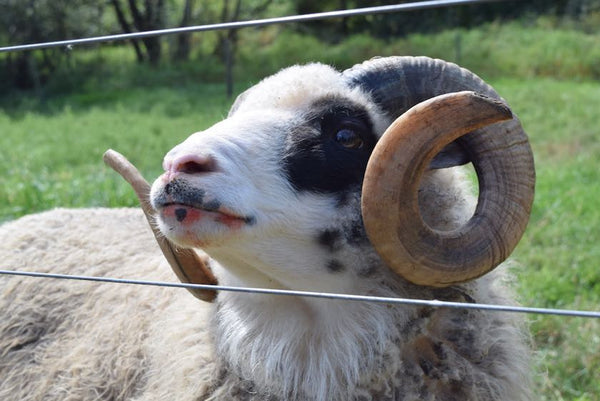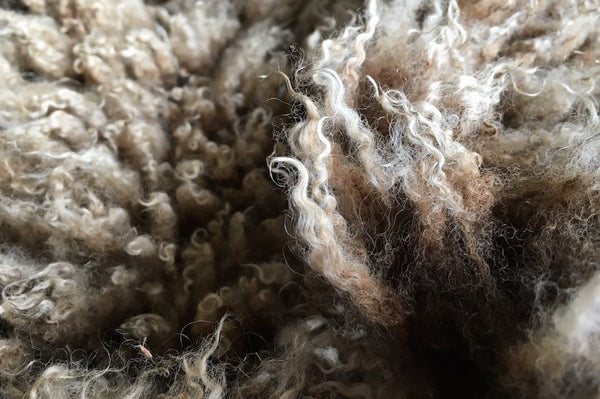Shop

Shetland
November 22, 2016 3 min read
Shetland wool has a rich and time honored history of devotion from its shepherds, including some of our own right here in the Pacific Northwest. Ananda Hills Farms, Whoamule Farm, and Thistle Hill Farm are neighbors to Abundant Earth Fiber and producers of the wool used to spin the 2016 Shetland Project. This project is more than just locally raised wool, though. It is a window into a remarkable breed that articulates the abundant nurture of our earth.
In a world where white is the dominant color of commercially processed wool, Shetland offers a wonderfully diverse palette of natural color. The breed recognizes a mind boggling array of colors and markings. It is impossible to understate the beauty of these colors brought to us by the effortless relationship between sheep and grass and sunshine.
If you wander the earth admiring the many colors of this wool, you will also discover there are three recognized Shetland breed types which have evolved to our present day.
Single Coated - These baby soft fleeces are short and downy, with high crimp and an average staple of about 2-4”.
Medium - With an average staple in the range of 4-6” and silky soft from cut end to curly tip, this is the most common type of Shetland.
Primitive - This is the oldest type of Shetland. Its origins are so old, in fact, they are untraceable. The Shetland name pays homage simply to its oldest known pastures. These fleeces with 6-10” staples are dual coated which means they have a shorter, downy undercoat providing warmth guarded by longer, more coarse fibers shielding the animal from wind and rain.
Across all three types of Shetland you’ll find a soft hand that does not compromise on strength. Although uniformity is the modern standard, there was a time when one sheep produced a wide variety of wool grades. Each fleece could then be sorted and utilized in many different ways. I am fascinated by the staggering attention to detail and handwork this implies.
Rooing is another mesmerizing attribute of Shetland fleeces. Usually in late winter or spring, the animal can produce a natural “break” or weak spot across the whole fleece. If you catch it while the break is still close to the skin, you can literally pull the fleece right off the animal. So cool, right? Here’s a video of Tori rooing a Shetland ewe.
Not surprisingly, the history of hand knitting and weaving with this remarkable wool is just as diverse as the attributes of its wool. Lace wedding shawls, fisherman sweaters, and all manner of intricate fair isle patterns have been particularly admired across the centuries. The northern islands of Great Britain are still dotted today with Shetland sheep, many of which have been contributing to the beloved Harris and Donegal tweeds for centuries.
2016 Shetland Project, designed by Susan Kroll, Thistle Hill Farm
Every opportunity to spin Shetland at my mill rewards me with the thrill of discovery in learning something new about something very old. I feel honored to take part in textile traditions that have connected humankind with mother earth for generations, especially with such an exceptional breed as Shetland.

Studio Reference is a category of posts containing technical insights and observations on working with natural fiber. The goal is to elevate our collective knowledge of textiles through an open dialogue about fiber. Please join the conversation with your own questions, comments and insights.
4 Responses
Linda Christiansen
June 23, 2017
I love learning about what you are doing at the mill. It was exciting to see the rooing of the sheep and seeing the pictures of the different kinds of sheep. It is also exciting to see all the different products and programs you are offering. Keep on spinning and weaving!
Alison
June 23, 2017
Rooing? Nifty I’ll say, didn’t know you could do that. Learned something today.
Shelby Smith
June 23, 2017
God forbid someone tortures a sheep thinking that wool is "gunna…come…OFF!" The gentle hand, the cooperative sheep, the obvious ease in the removal of this fleece speaks to impeccable timing and an experienced shepherd.Amazing. I love this breed!
Leave a comment
Comments will be approved before showing up.





Mary Morgan
December 28, 2017
I recently moved to the island, so good to know there are shetlands here. I had a pair of wethers at our old farm, they had the best personalities, smart and curious and fearless and friendly… and of course the wool was exceptional… off to see about where to buy some roving!